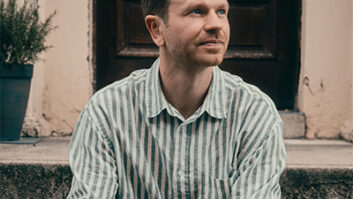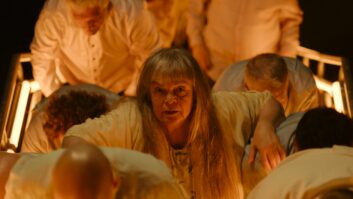The distinctive stylised production design and bold colour palette of international spy thriller The Little Drummer Girl was one which colourist Jet Omoshebi was at pains to accentuate in concert with director of photography Woo-hyung Kim.
Rather than taking a more conventional naturalistic or gritty approach to adapting John le Carré’s late 1970s tale, the creative execution deliberately draws attention to the artifice of Isreali undercover agents using an English actress to bring down a Palestinian terror cell.
The six-part primetime series is produced for the BBC and AMC by The Ink Factory, the team behind The Night Manager. It stars Florence Pugh, Alexander Skarsgard and Michael Shannon.
Director Park Chan-wook and Woo-hyung Kim took their striking vision to Goldcrest Post and Omoshebi in pre-production.
“The set design is so definite and striking that we were led very much by this from the start in discussions with director Park and Woo-hyung,” says Omoshebi. “We designed LUTs to have an underlying strong sense of blue as a bed for the central theme colours of yellow, blue, green, rust red and the red of the Mercedes which has become iconic of the whole show. Every single frame of the six hours has those key colours running through it.”
The director and DoP shared four still images of older films as reference points for presenting individual colour elements.
“Director Park is very detailed in his direction and meticulous in design so it was just a question of finding ways to bring those ideas forward. We treated this more like a feature film than an episodic drama.”
In that respect the workflow was similar to The Night Manager, which Omoshebi also graded. All six episodes were shot by one creative team, rather than broken into blocks like most drama. They were assembly edited before sending over to Goldcrest where she was able to treat the show as one piece rather than individual stories.
“Each episode leads into the next so it makes sense to treat the entire material as a whole,” she says. “With the rough assembly Woo-hyung and I had the luxury of three days to go through and discuss how it might look. In Resolve I was able to show him different features such as defocusing, sharpening and how blurs and flares from the OpenFX library might look.
“We took it all apart and put it all back together looking at all the different options.”
The show is shot on ARRI Alexa SXT at 3.4K resolution using older anamorphic lenses from which Goldcrest Post extracted a 16×9 frame.
“There’s a very creative use of the 2.35:1 aspect ratio to enhance the natural distortion of the lenses.”
In the event, while the grade is extensive it also treated the material cautiously.
You have to be sensitive with a period piece or it risks ending up being a pastiche of itself,” she says. “Director Park’s style is very crisp and clean but whenever you work in high resolution you have to look for ways to break it down a bit otherwise it can look too digital. So there are a few shots where we added a touch of grain and where the lenses created any artifacts we left them in.”
“His ambition was to always make this as filmic as possible. He’s not keen on having any really strong contrast that you wouldn’t necessarily find using a photochemical process. We kept the contrast quite soft so there aren’t many blown out whites or crushed blacks. Everything sits in the middle, run through with a kind of coolness while ensuring the theme colours popped.”
As is normal when a show is in editorial, the timelines of the actual shoot were juggled about (and needed attention), in addition to which the location shoot for Drummer Girl – which ranged from Greece to the Czech Republic – experienced some haphazard weather conditions.
“We replaced a lot of skies, added some sky detail and painted out items from scenes,” says senior online editor, Sinéad Cronin. “We have Flame and After Effects here but I do everything in Resolve, all the titles and credits, composites and digital FX. Resolve can handle it all. What’s great is that there’s no rendering so whenever I finish or a clip is updated Jet can open up the session immediately.”
Park Chan-wook sat in for most of the pre-grade after which Omoshebi sent files back to his home in Korea. Following discussion with Woo-hyung Kim the director then sent further notes back to Goldcrest for the finish.
“We have a complete Resolve workflow at Goldcrest which is great because it means you’re always on the same timeline,” adds Omoshebi. “Sinéad and I work very closely together so when she’s got one episode to a certain level I can begin to grade that while she works on the next episode. The sessions are really interchangeable and since the system can update things quickly we can have the entire project live all the way through the process.”







